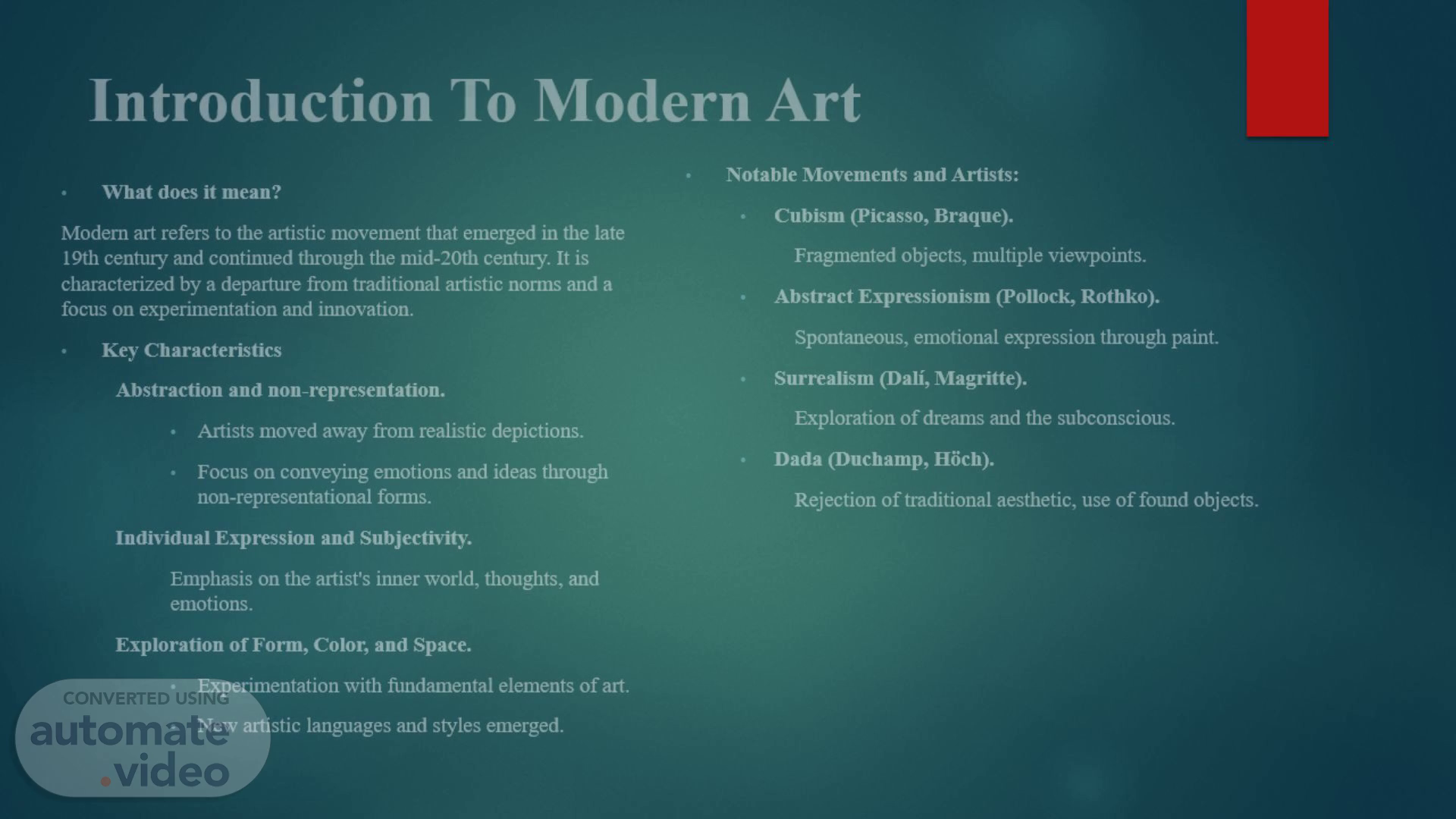
Introduction To Modern Art
Scene 1 (0s)
[Audio] Welcome to our exploration of Modern Art. In this journey, we'll delve into the late 19th to mid-20th century, witnessing the profound departure from traditional artistic norms. Modern art is a tapestry of diversity and experimentation, with artists pushing boundaries and redefining artistic expression. Let's explore the key characteristics that define this transformative movement. Abstraction and non-representation became pivotal, as artists moved away from realistic depictions to convey emotions and ideas through non-representational forms. Individual expression and subjectivity took center stage, reflecting the artist's inner world, thoughts, and emotions. Form, color, and space were no longer static; they became dynamic elements in the hands of innovative creators. As we navigate through modern art, we'll encounter notable movements and artists such as Cubism, Abstract Expressionism, Surrealism, and Dada, each contributing to the rich tapestry of this era.
Scene 2 (1m 7s)
[Audio] Our journey continues as we explore the evolution of styles in Modern Art, witnessing the dynamic shifts in the early, mid, and late 20th century. Early 20th-century movements like Cubism fragmented objects, Futurism celebrated the dynamism of the modern world, and Dada rejected conventional norms, incorporating found objects into artworks. Moving into the mid-20th century, Abstract Expressionism took center stage, emphasizing spontaneous, emotional expression through paint. Pop Art celebrated everyday objects, blurring the line between high and low art. Op Art engaged viewers in perceptual experiences with optical illusions and geometric patterns. As we approach the late 20th century, Minimalism embraced simplicity, Conceptual Art prioritized the idea behind the artwork, and Postmodernism blurred boundaries, creating an eclectic tapestry of influences..
Scene 3 (2m 8s)
[Audio] Now, let's explore the profound impact and enduring legacy of Modern Art, shaping not only the art world but also our cultural perceptions and societal norms. Modern art transformed the role of art in society, challenging established norms and fostering a spirit of rebellion and individualism. It became integrated into everyday life, influencing design, fashion, and architecture. The legacy continues in contemporary art, where artists draw inspiration from modern movements, contributing to ongoing experimentation. The influence extends to digital and multimedia art, reflecting the spirit of innovation seen in the modern era. The ongoing dialogue with traditional art ensures a dynamic and ever-evolving art landscape. As we conclude, let's recognize and appreciate the rich tapestry of artistic expression that Modern Art has woven, leaving an indelible mark on the world of art..
Scene 4 (3m 9s)
[Audio] In conclusion, we've journeyed through the diverse movements and styles within Modern Art, witnessing its transformative impact on the art world. Modern art, with its power to challenge norms and foster individual expression, extends beyond traditional boundaries, leaving an enduring legacy that continues to shape contemporary artistic expression. I encourage you to explore further, delving into specific movements or artists that resonate with you. As we navigate the ever-evolving art landscape, let's continue to embrace and celebrate the rich legacy of Modern Art. Thank you for joining us on this exploration. Feel free to ask questions or share your thoughts as we conclude our journey through the captivating world of Modern Art..